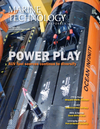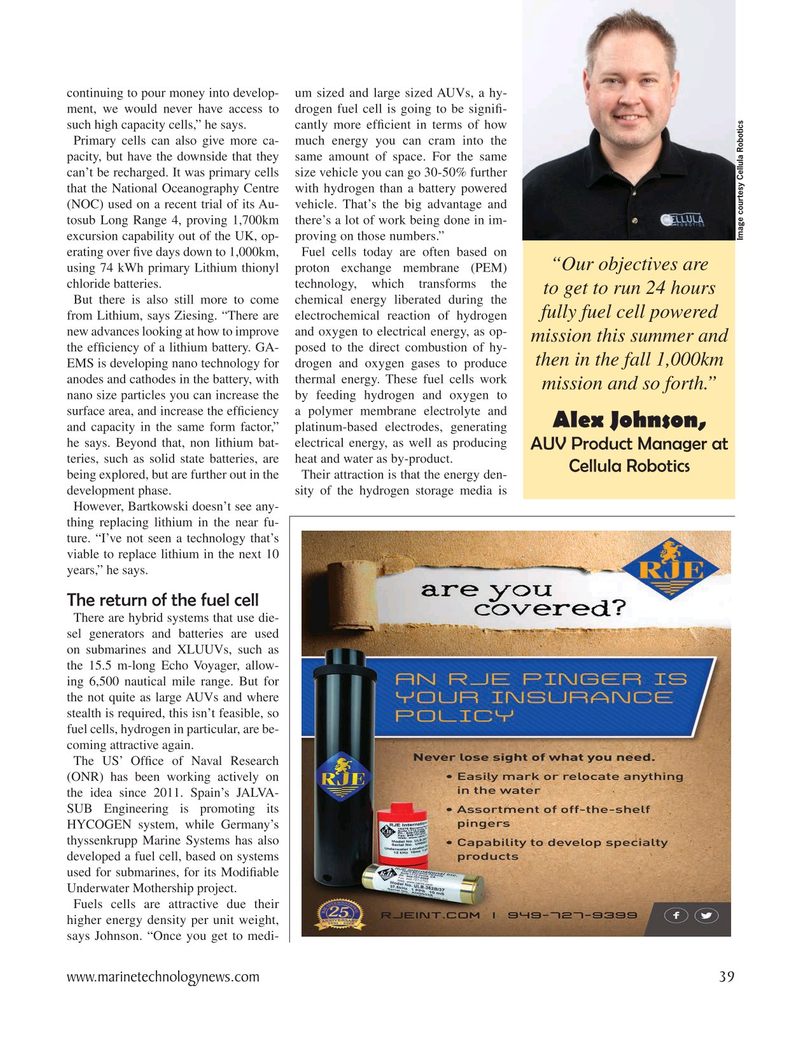
Page 39: of Marine Technology Magazine (July 2022)
Read this page in Pdf, Flash or Html5 edition of July 2022 Marine Technology Magazine
continuing to pour money into develop- um sized and large sized AUVs, a hy- ment, we would never have access to drogen fuel cell is going to be signi? - such high capacity cells,” he says. cantly more ef? cient in terms of how
Primary cells can also give more ca- much energy you can cram into the pacity, but have the downside that they same amount of space. For the same can’t be recharged. It was primary cells size vehicle you can go 30-50% further that the National Oceanography Centre with hydrogen than a battery powered (NOC) used on a recent trial of its Au- vehicle. That’s the big advantage and tosub Long Range 4, proving 1,700km there’s a lot of work being done in im- excursion capability out of the UK, op- proving on those numbers.”
Image courtesy Cellula Robotics erating over ? ve days down to 1,000km, Fuel cells today are often based on “Our objectives are using 74 kWh primary Lithium thionyl proton exchange membrane (PEM) chloride batteries. technology, which transforms the to get to run 24 hours
But there is also still more to come chemical energy liberated during the fully fuel cell powered from Lithium, says Ziesing. “There are electrochemical reaction of hydrogen new advances looking at how to improve and oxygen to electrical energy, as op- mission this summer and the ef? ciency of a lithium battery. GA- posed to the direct combustion of hy- then in the fall 1,000km
EMS is developing nano technology for drogen and oxygen gases to produce anodes and cathodes in the battery, with thermal energy. These fuel cells work mission and so forth.” nano size particles you can increase the by feeding hydrogen and oxygen to surface area, and increase the ef? ciency a polymer membrane electrolyte and
Alex Johnson, and capacity in the same form factor,” platinum-based electrodes, generating he says. Beyond that, non lithium bat- electrical energy, as well as producing
AUV Product Manager at teries, such as solid state batteries, are heat and water as by-product.
Cellula Robotics being explored, but are further out in the Their attraction is that the energy den- development phase. sity of the hydrogen storage media is
However, Bartkowski doesn’t see any- thing replacing lithium in the near fu- ture. “I’ve not seen a technology that’s viable to replace lithium in the next 10 years,” he says.
The return of the fuel cell
There are hybrid systems that use die- sel generators and batteries are used on submarines and XLUUVs, such as the 15.5 m-long Echo Voyager, allow- ing 6,500 nautical mile range. But for the not quite as large AUVs and where stealth is required, this isn’t feasible, so fuel cells, hydrogen in particular, are be- coming attractive again.
The US’ Of? ce of Naval Research (ONR) has been working actively on the idea since 2011. Spain’s JALVA-
SUB Engineering is promoting its
HYCOGEN system, while Germany’s thyssenkrupp Marine Systems has also developed a fuel cell, based on systems used for submarines, for its Modi? able
Underwater Mothership project.
Fuels cells are attractive due their higher energy density per unit weight, says Johnson. “Once you get to medi- www.marinetechnologynews.com 39
MTR #5 (34-49).indd 39 6/30/2022 1:26:49 PM

 38
38

 40
40
